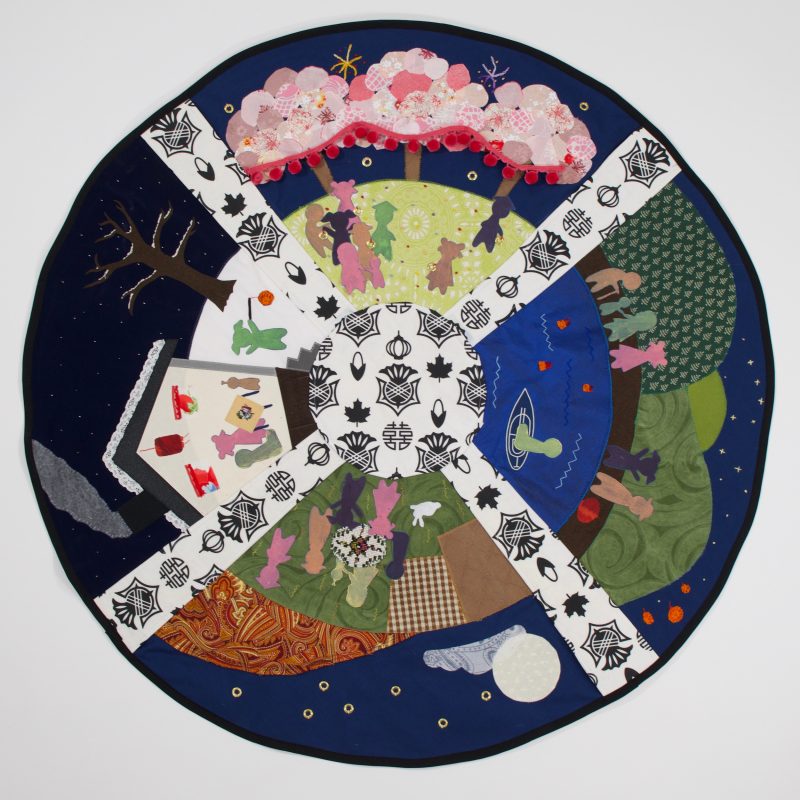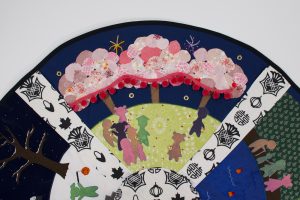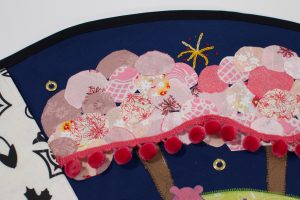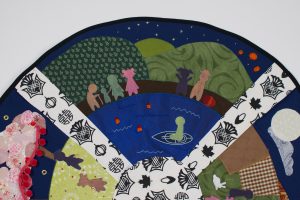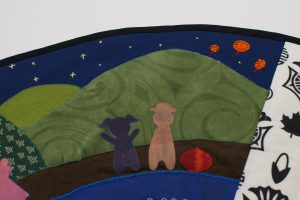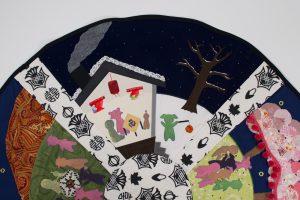Encoded Cloth – Team 2 Documentation
Intention
When we started the encoded cloth project, our initial idea was to create something that can represent the cultural background of all four members of our group. Since two of us come from America and two of us come from China, we decided to combine the elements from these two cultures and apply them in our work. We started by each discussing the features that we consider as the most important to our cultural background, and we found that landscape seemed to be an essential part for the two of us that are from America and people/festivals seemed to be more important for the two of us that are from China.
We then came up with the idea of creating a cloth with the shape of a circle and dividing it into four parts, with each part representing a season. We chose the circle as the shape of our cloth because it represents the cycle of a year, and it makes sense since we are doing the season theme. For each season, we depicted a Chinese festival/cultural event in the foreground and American landscape in the background, since we believed that it can demonstrate the combination of cultures. Each section is made by two people in our group, one from America and one from china, so that the entire project could be more cohesive. Each of us also provided a symbol, and we put these together around the CMU university seal. It represents that CMU forms the connection between all of us. We screen printed this pattern, and used it as the center part of the cloth and the boundaries between the seasons.
Process
Because most of our scenes are set at evening or night, we chose a dark blue cloth as the background for all four sections. Most of our pieces are attached using iron-on adhesive. For some pieces, we would also sew around the edge to secure the fabric down. We made each section individually and then connected them together using strips of muslin behind the borders. For the four spokes and the center we used the adhesive to attach our screen printed fabric to batting and then attached those pieces on top of the piece. We often chose iron-on adhesive because it was the simplest and most versatile way to attach fabric.
The Spring section is intended to depict the Spring Festival which is the most important festival in Chinese culture when families get together to celebrate the arrival of a new year. Moreover, the characteristic landscape of the season in the US is the cherry blossom trees in Washington DC. Thus, we chose to use different shades of pink as the cherry blossom flowers and light green as the lawn foreground. To add to the festive atmosphere, we did french knots on the foreground to represent flowers on the lawn and attached some metal o-rings to the hands of the people. We used the pink pom-pom as lanterns hanging in the trees because it not only closely resembles the shapes but also brings a three-dimensional texture to the piece. We also did chain stitch for the fireworks to make the scene more lively.
The Summer section depicts the ghost festival when people remember friends and family who have passed away. Since lanterns are a traditional part of the ghost festival we used lace sewn over red fabric to create lanterns on the water and in the sky. The landscape is the Appalachian mountains covered in their green summer foliage. We chose a variety of green fabrics to make the mountains distinct and shiny blue cloth with a person in a boat to indicate the foreground was a water scene. We used embroidery in the sky to make stars (including the big dipper, a recognizable summer constellation).
The Fall section depicts the mid-autumn festival when people gather with their families to celebrate the harvesting season and to miss the family members far away from home. Traditions include eating mooncakes and appreciating the full moon, leading to our design of the full moon in the night sky and people gathering around the table in the field which is more of an American landscape. The overall color scheme is darker than Spring’s due to the seasonal difference in reality. Because the major colors of fall are red and orange, we chose to piece together fabric with red and orange patterns together to resemble the autumn trees on the hill. This pieced fabric was then sewn to batting to add texture. The metal o-rings are attached to represent the shining stars at night, and the rabbit made of white felted cloth relates to a myth about the origin of mid-autumn festival. We also did some machine stitching patterns using yellow and gold threads in the dark green foreground to resemble crops.
The Winter section depicts an everyday home scene with people gathered around a table at the end of a day. Lanterns were added using methods similar to those used in the summer section to add continuity to the piece. The landscape is a peaceful and quiet winter scene. Snow is represented by the white fabric in the foreground, embroidery in the sky/tree, and lace on the roof. The tree itself was designed in Illustrator and then laser cut.
Learning
We each learned a variety of things on this project. Many of these were fabrication skills. We learned more about embroidery techniques, using a sewing machine, printing designs on fabric, and using iron on adhesive. We also learned how to work on a group art piece. Many of us have been in group projects before, but none with such an emphasis on the aesthetics of the final result. It helped to have an initial plan that we were open to adjusting as we continued with the fabrication process. It helped us have a cohesive final product. This also allowed people to on small details as they had free time, which helped when our schedules didn’t work together.
During the critique many of our classmates mentioned that the screen-printed patterns separating the sections might not fit into the background. If we were to do this project again, we may try to redesign that part to make the whole piece more consistent. We would look into not using the adhesive for fabricating the dividers/center piece. The adhesive gave those areas a very stiff and almost oily texture that would be nice to avoid.
